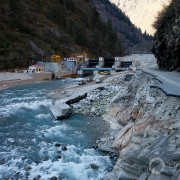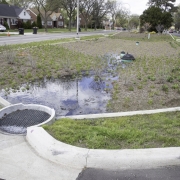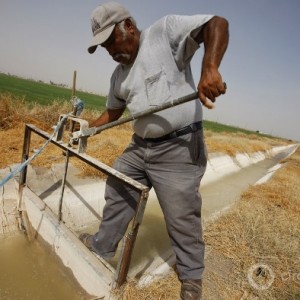California Water Restrictions Still Target Lawns
Few substantial changes to the latest version of conservation regulations.

By Brett Walton
Circle of Blue
California regulators made a few changes on the margins, but the heart of the state’s proposal to cut urban water use by 25 percent was unaltered in official draft regulations released Tuesday night.
Reducing outdoor water use, chiefly lawn watering, is still the primary objective for meeting the state’s first-ever mandatory urban water restrictions.
–Felicia Marcus, chair
State Water Resources Control Board
The draft regulations divide the state’s 411 urban water suppliers into nine conservation tiers that range from 4 percent to 36 percent. The tiers are based on last summer’s residential water use, and those cities with higher water use per person must cut more deeply.
Officials argued that strong measures are needed today in case the drought stretches for several more years.
“We need to take actions now that we’ll be glad we took if the drought does last longer,” said Felicia Marcus, chair of the State Water Resources Control Board, during a press call announcing the rules. Earlier in the day, Brown proposed new legislation that would allow water utilities to fine the most egregious water wasters up to $US 10,000.
The rules on restrictions, which will be finalized at a May 5 meeting of the Water Board, will go into effect immediately because water use is greatest in the summer. On average, lawn watering accounts for half of residential water use, and 70 percent or more in arid interior regions.
“If we don’t get [the reductions] in the summer, we’re not going to make the overall target,” said Max Gomberg, a senior staff scientist at the Water Board. The board will begin assessing monthly water use compared with a 2013 baseline beginning with the June 2015 data, which will be released July 15.
Regulators Remember Australia
Since Governor Jerry Brown outlined the 25 percent goal in an April 1 executive order the Water Board has been operating in hurry up mode. The water regulator issued two preliminary versions of the rules before the official draft was released Tuesday. Each version was refined following a round of public comments.
“We’re trying to find the sweet spot of what is aggressive, fair, and doable,” Marcus said at an April 27 water forum hosted by the University of Southern California’s Schwarzenegger Institute.
In recent days, Marcus has frequently cited Australia’s experience during its Millennium Drought as a guiding star for California. Over more than a decade of deep drought, Australian officials learned that delaying difficult decisions about cutting water use only worsens the consequences, Marcus explained.
“Their advice was: conserve early to save pain and expense later on,” Marcus said.
The Water Board is accepting public comments on the draft rules through May 4. Officials are particularly interested in two questions:
- Whether the conservation tiers should be sliced even thinner, in effect going from nine 4-percent stair steps to 15 blocks that increase by 2 percent.
- What the criteria should be for allowing cities to move to a lower conservation tier. Criteria in the draft rules include water source, precipitation in the last year, and water held in storage.
The Water Board received more than 200 comments on its previous draft, many of which came from cities in higher conservation tiers. They requested changes to the board’s methodology for calculating the tiers. The board rejected the requests — which included exemptions for regions with hotter climates or those that invested in recycled water — because the changes would have shifted more of the burden to cities that had already conserved, said Caren Trgovcich, chief deputy director of the board.
Most of the changes in the most recent draft are minor. Water suppliers, in their monthly reports, will not be required to break down commercial, industrial, and institutional water use. Instead, they can submit a single number. Water Board officials said the change was made because some smaller suppliers said they did not have data at that level of detail.
Roughly a dozen suppliers were placed into a different tier. Gomberg said this was because they changed the water use figures they reported to the state.
“We’re reviewing these to determine if they are legitimate,” Gomberg added. “We’re not just accepting these without explanations.”

Brett writes about agriculture, energy, infrastructure, and the politics and economics of water in the United States. He also writes the Federal Water Tap, Circle of Blue’s weekly digest of U.S. government water news. He is the winner of two Society of Environmental Journalists reporting awards, one of the top honors in American environmental journalism: first place for explanatory reporting for a series on septic system pollution in the United States(2016) and third place for beat reporting in a small market (2014). He received the Sierra Club’s Distinguished Service Award in 2018. Brett lives in Seattle, where he hikes the mountains and bakes pies. Contact Brett Walton
Leave a Reply
Want to join the discussion?Feel free to contribute!











Hey! Brown proposed (La Voile) new legislation that would allow water utilities to fine the most egregious water wasters up to $US 10,000.